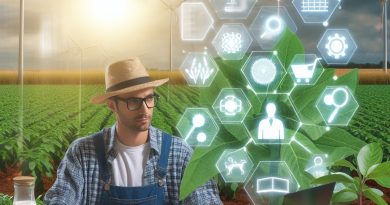Solar Power in Farms: A Green Revolution
Last Updated on March 2, 2024
Introduction
Solar power represents an immense renewable energy source with untapped potential for agriculture.
Solar panels convert sunlight into electricity through photovoltaic cells.
This harnesses the abundant, free rays from the sun to generate clean energy.
As concerns mount around fossil fuel dependence and climate change, solar offers a sustainable solution.
Agricultural operations require considerable energy across machinery, lighting, heating and more.
Solar power can sustainably meet modern farming’s electricity needs.
By installing solar infrastructure, farms can slash their greenhouse gas emissions and utility bills.
This technology presents a win-win opportunity to cut costs and environmental impact.
This article will focus on solar power applications tailored to agriculture’s unique needs.
Topics covered include solar-powered irrigation, farm equipment, livestock operations, and more.
With smart integration, solar energy can run farms of the future.
The technology is here and costs are falling steadily.
By tapping into the sun, growers can insulate themselves from volatile fuel prices and play a key role in the renewable energy transition.
The time is now for farming’s solar revolution.
Read: Agri Drones: Changing the Farming Landscape
Benefits of Solar Power in Farms
Environmental benefits
- By utilizing solar power, farms significantly reduce greenhouse gas emissions.
- Solar power helps combat climate change by producing clean and renewable energy.
- It preserves natural resources as it relies on the sun’s endless supply of energy.
Economic benefits
- Solar power in farms reduces energy costs, resulting in significant savings for farmers.
- It lowers the reliance on the grid, making farms more self-sufficient and resilient.
- Farmers can generate additional income by selling excess energy produced by their solar installations.
Social benefits
- Solar power enhances sustainability practices, demonstrating a commitment to a greener future.
- By embracing solar energy, farms promote a positive image of being environmentally responsible.
- Solar farms inspire community involvement and provide educational opportunities for local residents.
In recent years, solar power has emerged as a game-changer in the agricultural sector.
By harnessing the abundant energy from the sun, farms have the opportunity to transition towards a more sustainable and environmentally friendly future.
The numerous benefits offered by solar power make it a green revolution that is worth embracing.
Environmental benefits
One of the most significant advantages of solar power in farms is the environmental benefit it brings.
By utilizing solar panels to convert sunlight into electricity, farms can greatly reduce their greenhouse gas emissions.
This reduction plays a crucial role in mitigating the impacts of climate change, making solar power an essential tool in the battle against global warming.
Furthermore, solar power is a clean and renewable energy source that preserves natural resources, as it does not deplete fossil fuels or contribute to harmful air pollution.
Economic benefits
Aside from the positive environmental impact, solar power also brings significant economic advantages to farms.
By generating their own electricity, farms can significantly reduce their energy costs.
In the long run, this translates into substantial savings, allowing farmers to allocate their resources more efficiently.
Additionally, solar power empowers farms to lower their reliance on the grid, enhancing their self-sufficiency and resilience against power outages or grid failures.
Moreover, by installing solar panels and generating excess energy, farmers have the potential to earn extra income by selling electricity back to the grid.
Social benefits
The benefits of solar power extend beyond the environmental and economic aspects, encompassing significant social advantages for farms.
Embracing solar energy enhances sustainability practices, showcasing a farm’s commitment to reducing its environmental footprint.
This commitment fosters a positive image for the farm, attracting environmentally conscious consumers and stakeholders.
Solar farms become champions of renewable energy, inspiring neighboring communities to participate in the green revolution.
Furthermore, they provide an excellent opportunity for community involvement and education, where residents can learn about the benefits of solar power and its importance in achieving a sustainable future.
In essence, the adoption of solar power in farms offers a multitude of benefits across various aspects.
The environmental advantages, including reduced greenhouse gas emissions and preservation of natural resources, contribute to combating climate change.
Economically, solar power reduces energy costs, lowers reliance on the grid, and provides opportunities for additional income.
Socially, it enhances sustainability practices, promotes a positive image, and encourages community involvement and education.
The integration of solar power in farms paves the way for a green revolution, leading to a greener and more sustainable agricultural sector.
Read: Solar-Powered Irrigation: A Deep Dive
See Related Content: Greenhouse Tech: Future of Controlled Agri
Implementing Solar Power Systems on Farms
When implementing solar power systems on farms, several key steps need to be followed to ensure successful adoption.
These steps include assessing energy needs and capacity, conducting a feasibility study, selecting the right solar power system, and properly installing and maintaining the system.
Assessing energy needs and capacity
To begin, farmers need to analyze their current energy consumption to understand their needs.
This analysis will help determine the appropriate size of the solar power system required to meet their energy demands.
Conducting a feasibility study
Before moving forward, it is crucial to evaluate the availability of sunlight on the farm.
This helps determine the feasibility of installing solar panels.
Additionally, considering the terrain and available space is essential to identify any potential challenges and maximize the efficiency of the system.
Selecting the right solar power system
Farmers must choose the most suitable solar power system for their specific needs.
This involves considering the different types of solar panels available and understanding their advantages and disadvantages.
Furthermore, the use of storage batteries can provide added benefits, such as energy backup during cloudy days or peak demand periods.
Exploring financing options and government incentives is also crucial in this selection process.
Installation and maintenance
Once the appropriate system has been selected, finding reputable solar installation providers is essential.
These professionals will ensure the proper installation of the solar panels and associated equipment.
Regular inspections and maintenance of the system are vital to ensure optimal performance and longevity.
Safety measures must also be followed to protect workers and comply with regulations.
Implementing solar power systems on farms can lead to substantial benefits.
Notably, it can significantly reduce electricity costs, provide energy independence, and contribute to a greener environment.
By following these steps, farmers can adopt sustainable practices and contribute to a green revolution.
Read: Agri Solar Panels: Powering Farms Sustainably

Case Studies: Successful Solar Power Integration in Farms
Farms that have successfully implemented solar power systems
- Their motivations and goals: One farm, Green Acres, implemented solar power to reduce reliance on fossil fuels and cut costs. Another farm, Sunny Meadows, aimed to reduce their carbon footprint and become more sustainable.
- Benefits they have experienced: Green Acres has seen a significant reduction in their energy bills since installing solar panels. Sunny Meadows has been able to sell excess electricity back to the grid, providing additional income.
- Challenges encountered and how they were overcome: Green Acres faced initial resistance from traditional farmers but educated them about the benefits. Sunny Meadows invested in a battery storage system to overcome the challenge of intermittent solar power.
Lessons learned from successful solar power integration in farms
- Implementing proper planning and research: Both Green Acres and Sunny Meadows conducted extensive research before installing solar power systems. This allowed them to choose the most suitable solar panels and equipment for their specific needs.
- Securing funding and incentives: Green Acres secured a government grant for their solar power project, covering a significant portion of the costs. Sunny Meadows took advantage of tax credits and incentives specifically aimed at renewable energy projects.
- Collaborating with experienced solar power providers: Both farms worked closely with solar power companies to design and install their systems. This ensured that the solar panels were properly aligned and optimized for maximum energy generation.
Potential challenges and concerns in implementing solar power in farms
- Land availability and suitability: Some farms may have limited space or unsuitable terrain for solar panels. Innovative solutions like solar canopies or panel tilt adjustments can overcome this challenge.
- Maintenance and durability: Regular maintenance is crucial to ensure optimal energy generation. Farms need to allocate resources for cleaning and repairing solar panels when necessary.
- Integration with existing infrastructure: Farmers need to consider how solar power systems can seamlessly integrate with existing farm infrastructure, such as electrical connections and water pumps.
Future potential of solar power in farms
- Scaling up solar power integration: As technology advances and costs decrease, more farms can adopt solar power on a larger scale, contributing to a greener agricultural sector.
- Expansion into other renewable energy sources: Farmers can explore integrating solar power with wind or bioenergy systems to further reduce their carbon footprint and enhance energy self-sufficiency.
- Leveraging smart technologies: Farmers could utilize smart technologies like sensors and automation to monitor and optimize the performance of solar power systems, maximizing their efficiency.
In a nutshell, these case studies highlight the successful integration of solar power in farms while discussing motivations, benefits, and challenges faced.
Lessons learned from these farms can serve as a guide for other agricultural businesses looking to embrace a green revolution through solar power integration.
With careful planning, funding, collaboration, and addressing potential challenges, farms can contribute to a sustainable future while reaping the economic and environmental benefits.
Read: Eco-Friendly Farming: Top Sustainable Practices
You Might Also Like: Breakthroughs in Soil Health: Agri-Tech’s Role
Conclusion
Harnessing solar energy offers immense potential to power a revolution in sustainable agriculture.
As highlighted, solar panel infrastructure provides clean, renewable electricity.
This slashes reliance on fossil fuels while reducing energy costs substantially over time.
Solar energy can meet the considerable power needs of modern farms through creative integration across operations.
Capturing the sun’s abundant rays to run equipment, heat buildings, and more provides a free, green fuel source.
Additionally, the long-term savings and energy independence solar offers provides financial stability for growers.
Farmers should strongly consider joining the transition to this clean technology, starting with small steps like solar-powered lighting.
With solar power, the future of agriculture can run on clean energy from the sky.
The transition may seem daunting, but the environmental and economic benefits are well worth the investment.
By embracing innovation, farmers can lead the charge in building a brighter future.
One where growing food and protecting the planet go hand in hand.
The technology is ready – now is the time to harness the sun and power a green revolution in agriculture.
The future is solar.


